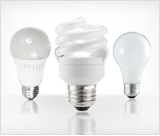Lighting is more than just replacing a lamp or ballast, it also has to do with color. We have just helped Sterling Graphics with a move into a new space. The kelvin temperature and CRI of the lamps they use are very important for their graphics business as they must have exact color matching ability.
The kelvin temperature is often referred to as the color appearance of the light source – is it cool and crisp or warm and cozy? This is a number system that ranges from 2700-6500. CRI or color rendering index is the ability of the light source to reflect back to the eye the colors we expect to see in an object, this is ranked on a scale of 0 to 100. Clear daylight is considered as a reference point of 100.
Some of the other businesses that we have helped that require accurate attention to these 2 factors are Dentists, auto body repair shops, craft and paint stores. Lighting matters!



